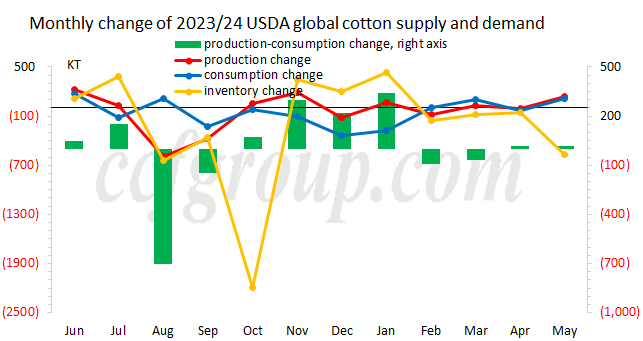Interpretation of USDA's May supply and demand report on cotton
1. USDA significantly lowers global cotton stocks for the 2023/24 season
Last Friday, the United States Department of Agriculture (USDA) released the May global cotton supply and demand balance sheet. This adjustment primarily involved a significant reduction in the beginning and ending stocks for the 2023/24 season, along with increases in production and consumption. Specifically, the beginning stocks were lowered by 480,000 tons, and ending stocks by 570,000 tons, while production saw a slight increase of 140,000 tons and consumption rose by 120,000 tons. Mainly, this was due to consumption increases exceeding 100,000 tons each in China and India. Production increases were mainly attributed to India, with China and Brazil remaining relatively stable. Overall, the significant decrease in the beginning and ending stocks globally, due to reduced beginning stocks in Brazil and India, coupled with a substantial improvement in recent US cotton export sales. Moreover, significant increases in Southeast Asian imports of US cotton are expected to provide support to short-term international cotton prices.

2. USDA releases first balance sheet for the 2024/25 season
Compared to the previous season's data, the new season's balance sheet mainly increased production, consumption, and ending stocks. Due to a slight increase in planted area and abandonment rate less than half of that in 2023, the US production forecast for the 2024/25 season is significantly increased by 860,000 tons. Additionally, following CONAB's adjustment of Brazilian production to 3.6 million tons in April, USDA also raises Brazil's cotton production forecast by 460,000 tons to 3.64 million tons. Meanwhile, production in India and China for the new season has declined slightly, but the overall production expectation still shows a significant increase of 1.19 million tons compared to the 2023/24 season. Although consumption is adjusted by 760,000 tons, ending stocks are still expected to rise by 550,000 tons. Therefore, in the medium to long term, there is still room for downward movement in ICE cotton futures, contingent upon macro variables such as the US dollar index.
Overall, in May, USDA makes its first estimation for global cotton for the 2024/25 season, with the substantial increase in production being a significant bearish factor for future international cotton prices. While consumption has increased, whether it can be realized depends on the extent of the downward pressure on ICE cotton and whether global demand can recover. In reality, despite the significant increase in Southeast Asian imports of US cotton in the short term, and China's cotton imports exceeding market expectations in the prior two months, this is largely influenced by the low price of US cotton and China's state reserve purchases. Whether these variables can continue to hold in the 2024/25 season remains uncertain. Therefore, this estimation for the 2024/25 global cotton market lean more towards bearish than bullish, thus maintaining the view that international cotton prices may be range-bound in the short term but remain weak in the medium to long term.
- Top keywords
- Cotton Price
- Cotton Futures Price
- Cotton Futures
- CZCE
- PTA Futures Price
- Chemical Fiber
- Polyester Prices
- Wool price
- PTA Futures
- Shengze Silk
- China
- Yarn Price
- price
- China Textile City
- Fibre Price
- Benzene Price
- Cotton
- Index
- Cotton Index
- PTA
- fabric price
- NYMEX
- Top 10
- textile industry
- Spot Cotton
- Cotton Yarn
- Polyester Price
- Futures
- PTA Price
- cotton yarn price

